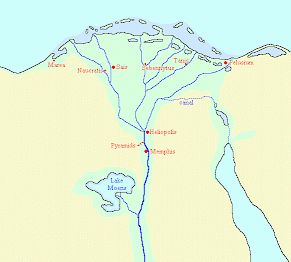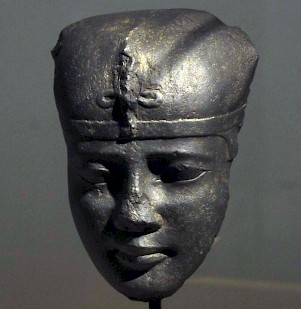Nectanebo I
Nectanebo I (Egyptian: Nakhtnebef): pharaoh of Egypt, ruled 378-361/360.
Context

In the fifth century BCE, Egypt had been part of the Achaemenid Empire. However, in 404, a quarrel had started between king Artaxerxes II Mnemon and his younger brother Cyrus, which had lasted until 401. The Egyptians, led by Amyrtaeus, had seized the opportunity to regain their independence.;
Amyrtaeus had been succeeded by Nepherites I and Achoris. Persian attacks in 385 and 383 had been repulsed by Egyptian soldiers and Greek mercenaries, commanded by the Athenian general Chabrias, and a period great prosperity had started.
Coup
When Achoris died in 379, there was unrest in Egypt, and his son Nepherites II occupied the throne for just four months. His murderer and successor was Nakhtnebef or Nectanebo, who may have been a distant relative of Nepherites I but was - whatever his family connections - an usurper. His home town and residence was Sebennytus, a city in the heart of the Delta of the Nile.
The Persian War

The Persian king Artaxerxes II Mnemon was aware of the troubles surrounding the accession of Nectanebo, and decided to attack Egypt. In 386, he had concluded a peace treaty with the Greeks, and under the terms of this treaty, he requested the Athenians to recall Chabrias (379). So, Egypt was left without allies, and the Persians started to prepare themselves, which took several years. Finally, their general Pharnabazus gathered a large navy at Acre in southern Phoenicia. His army was reinforced with Greek mercenaries, commanded by the Athenian Iphicrates (Spring 373).
Their advance to Egypt was uneventful, which suggests that Nectanebo did not possess a navy that could attack the Persians during their five days' march through the desert between Gaza and Pelusium (i.e., Port Said). However, Pelusium, situated on the most eastern branch of the Nile, was strongly defended, and the Persians were unable to capture the Egyptian stronghold.

Therefore, they decided to go around it and used the next branch of the Nile to enter the country. The fortress that guarded the entrance of this branch was razed to the ground. During their march on Memphis, however, Iphicrates and Pharnabazus started to disagree about their policy, and they hesitated to attack the Egyptian capital. Nectanebo was able to reinforce Memphis, and in July 373, his enemies were forced to retreat: because of the Nile inundation, the Delta had become one great swamp. Pharnabazus had underestimated the Egyptian strength and the logistics of the campaign.
It was an important Egyptian victory. The Persians were unable to come back. After 370, the west of their empire was in great turmoil (a period known as the Satrap's revolt), and it took Artaxerxes II and his successor Artaxerxes III Ochus much time to reestablish their power.
Domestic Policy

For Egypt, the fact that it had - without allies! - defeated the most powerful state in the world, meant the beginning of a national restoration. Nectanebo rebuilt and enlarged several important temples (e.g, at Bubastis, Memphis, Abydus, Thebes/Karnak, and Edfu) in a style that is reminiscent of the buildings of the Twenty-Sixth Dynasty, which had been the last native dynasty before the conquest by the Persian king Cambyses in 525.
In the last years of Nectanebo's reign, he negotiated with some of the rebellious Persian satraps, and plans were made for an attack on the Achaemenid empire, where Phoenicia was a natural target for Egyptian expansion. Athens no longer felt obliged to obey the Persian king, and Chabrias was sent back to Egypt. However, the execution of the plan was left to Nectanebo's son Teos, who had already been made co-ruler in 365.
Nectanebo died in 361/360 after a reign of 18 years.